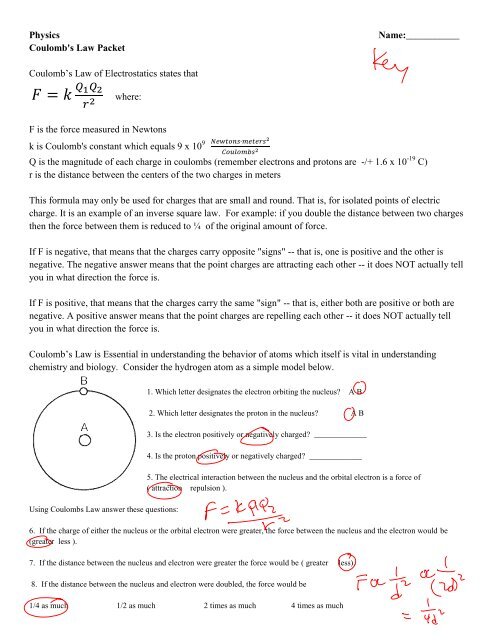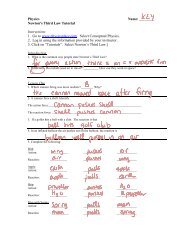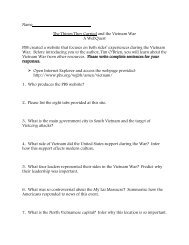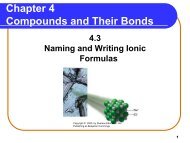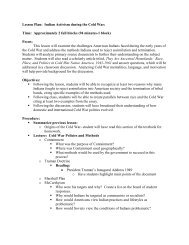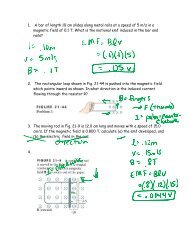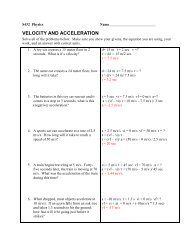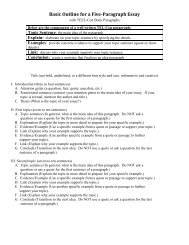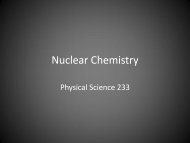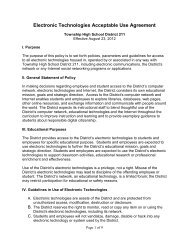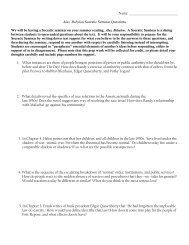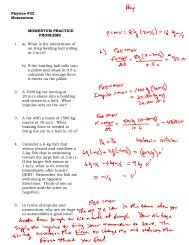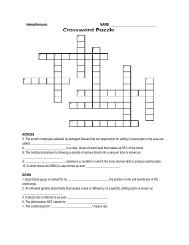Coulomb's Law Packet Coulomb's Law of Electrostatics states that ...
Coulomb's Law Packet Coulomb's Law of Electrostatics states that ...
Coulomb's Law Packet Coulomb's Law of Electrostatics states that ...
- No tags were found...
Create successful ePaper yourself
Turn your PDF publications into a flip-book with our unique Google optimized e-Paper software.
Physics<strong>Coulomb's</strong> <strong>Law</strong> <strong>Packet</strong>Name:___________Coulomb’s <strong>Law</strong> <strong>of</strong> <strong>Electrostatics</strong> <strong>states</strong> <strong>that</strong>where:F is the force measured in Newtonsk is <strong>Coulomb's</strong> constant which equals 9 x 10 9Q is the magnitude <strong>of</strong> each charge in coulombs (remember electrons and protons are -/+ 1.6 x 10 -19 C)r is the distance between the centers <strong>of</strong> the two charges in metersThis formula may only be used for charges <strong>that</strong> are small and round. That is, for isolated points <strong>of</strong> electriccharge. It is an example <strong>of</strong> an inverse square law. For example: if you double the distance between two chargesthen the force between them is reduced to ¼ <strong>of</strong> the original amount <strong>of</strong> force.If F is negative, <strong>that</strong> means <strong>that</strong> the charges carry opposite "signs" -- <strong>that</strong> is, one is positive and the other isnegative. The negative answer means <strong>that</strong> the point charges are attracting each other -- it does NOT actually tellyou in what direction the force is.If F is positive, <strong>that</strong> means <strong>that</strong> the charges carry the same "sign" -- <strong>that</strong> is, either both are positive or both arenegative. A positive answer means <strong>that</strong> the point charges are repelling each other -- it does NOT actually tellyou in what direction the force is.Coulomb’s <strong>Law</strong> is Essential in understanding the behavior <strong>of</strong> atoms which itself is vital in understandingchemistry and biology. Consider the hydrogen atom as a simple model below.Using Coulombs <strong>Law</strong> answer these questions:1. Which letter designates the electron orbiting the nucleus? A B2. Which letter designates the proton in the nucleus? A B3. Is the electron positively or negatively charged? _____________4. Is the proton positively or negatively charged? _____________5. The electrical interaction between the nucleus and the orbital electron is a force <strong>of</strong>( attraction repulsion ).6. If the charge <strong>of</strong> either the nucleus or the orbital electron were greater, the force between the nucleus and the electron would be(greater less ).7. If the distance between the nucleus and electron were greater the force would be ( greater less).8. If the distance between the nucleus and electron were doubled, the force would be1/4 as much 1/2 as much 2 times as much 4 times as much
Refer to the following information for the next ten questions.Two charges, a +3x10-5C charge and a -6x10-5 C charge, are 2 meters apart.9. What is the magnitude <strong>of</strong> the original electrostatic force between them? Show all work below.10. Is it an attractive or repulsive force? ________11. How could you change the situation to reverse your answer to #10 ? _______________________________12. How would the original force change if the charges were moved twice as far apart? ___________________Calculate the force below.13. How would the original force change if the charges were moved towards each other to a final distance which equals half <strong>of</strong> theiroriginal separation? _______________Calculate the force below.14. How would the original force change if the charges were each doubled in size? _________________Calculate the force below.15. How would the original force change if each <strong>of</strong> the charges were to be cut in half? ________________Calculate the force below.
16. How would the original force change if the charges were each doubled in size as well being moved to a distance <strong>that</strong> is twice theiroriginal separation? Explain.17. Which <strong>of</strong> the following combinations <strong>of</strong> changes, involving both a change in the magnitude <strong>of</strong> the charges as well as theirseparation, could produce a force <strong>that</strong> is 64 times stronger than the original force between them?a) you could quadruple each charge and also move them to new positions which represent a distance <strong>that</strong> is only half <strong>of</strong> their originalseparationb) you could cut each charge in half and also move them to new positions which represent a distance <strong>that</strong> is 16 times greater than theiroriginal separationc) you could double one charge, quadruple the second charge and move them to new positions which represent a distance <strong>that</strong> is 8times greater than their original separationd) you could double each charge and also move them to new positions which represents a distance <strong>that</strong> is only one-fourth their originalseparationjustify your choice with a calculation18. One Coulomb is actually an incredibly large amount <strong>of</strong> unbalanced charge. To see why imagine you have two Styr<strong>of</strong>oam ballsleft over from when you had to make a model <strong>of</strong> the solar system. If one coulomb <strong>of</strong> charge were placed on each ball, how far apartmust the two balls be so <strong>that</strong> the force on these two balls is only 1 N (which is not very much force, it’s the weight <strong>of</strong> a small apple).Convert your answer to miles.19. Two spheres A and B are charged so <strong>that</strong> A has twice the charge <strong>of</strong> B. The force between the two spheres is 0.5 N and they are0.60 m apart. Find the charge <strong>of</strong> A and B. (Hint: call the charge <strong>of</strong> B “Q”)20. A nucleus <strong>of</strong> uranium contains 92 protons.A) What is the charge in Coulombs <strong>of</strong> 92 protons?B) If two <strong>of</strong> these nuclei experience a force 0.22 N how far apart are they?
Sample Problems:Given:Q1= 6.4 x 10 -7 CQ2=7.3 x 10 -7 CFelectric 0.3 Nk 9 10 9 Nm 2 /C 2Unknown: r ?Equation:Solve for r:and thenSubstitute the values and solve:=0.12 m2. Suppose you place equal but opposite amounts <strong>of</strong> charge at the Earth’s North and South Poles. How much charge isat each pole if the magnitude <strong>of</strong> the electric force compressing Earth is 5.17 10 5 N? Earth’s diameter is 1.27 10 7 m.Given:Felectric 5.17 10 5 Nr 1.27 10 7 mk 9 10 9 Nm 2 /C 2Unknown: q ?Equation:Solve for Q since they are equaland then rearrangeand finallySubstitute the values into the equation(s) and solve:Even though the force is attractive (-) we don’t put the minus sign into the equation because we really don’t know what direction theforce is.


